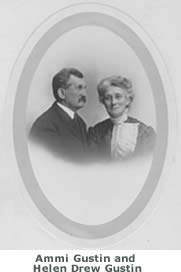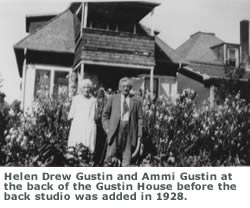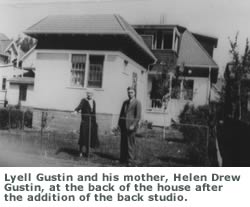Gustin House, History

Lyell Gustin, youngest son of Ammi and Helen Drew Gustin, moved to Saskatoon with his parents from the Eastern Townships of Quebec in 1912. Eight years later, the lot at 512 Tenth Street in the Broadway district of Saskatoon was purchased by the Gustins so that a residence with a teaching studio could be built there. The lot already had a building on it, a small house constructed in 1883 in which the Trounce family had lived from 1884 to 1887. This building was moved to the back of the lot, where it was later used as a garage/shed. The present house was constructed at the front of the lot and the Gustins moved into it in November of 1920. This would become Lyell Gustin's residence for the rest of his life. Due to his outstanding career, the Gustin home came to achieve a prominence in music circles unequalled by any other house in Saskatoon.
The house was a two-storey building. The eastern half of the lower storey consisted of a front hall, a den-dining room and a kitchen, and the western half had two large rooms, the front room being used as a piano studio. A large front porch provided extra space from spring to early autumn. In 1928 the lower storey was enlarged by having a large room added to the back of the house with a narrow room connecting it to the earlier part of the house. The narrow room was used as a library and the large room was used for teaching, giving the house facilities for two teachers. The two teaching rooms came to be called the front studio and back studio. For many years there was a grand piano and an upright in each studio. In his later years, Mr. Gustin taught only in the back studio with its two Steinways--a grand and an upright--while the front studio was used as a sitting room. Sliding doors provided wide access to the studios when open and a certain amount of sound-proofing when closed. These four rooms constituted the teaching area of the house and were called The Lyell Gustin Piano Studios or simply "the Studios," as many students fondly referred to them.

Architecturally, the building is a good example of residences of the 1920s era. However, the greater heritage significance of the house derives from the career of Lyell Gustin and the musical-cultural impact he had on so many over such a long period of time. The Studios were the scene of some of the finest performances heard in Saskatoon. The musical activities which took place there were an inspiration to hundreds of students, and distinguished graduates carried the Studios' reputation for excellence in music across Canada, to the United States and to Europe.

For many months after Mr. Gustin's death it seemed that The Studios would cease to exist with the house being put up for sale and the contents sold at public auction. A number of former students were reluctant to see this happen but it appeared as if little could be done to prevent such a dispersal. Fortunately, Don Irvine, a scientist at the University and an amateur historian, had made a study of the garage at the back of the lot, correctly identifying it as the residence of the Trounce family and as the oldest building still standing in Saskatoon. He had started the study in 1987 and had even interviewed Mr. Gustin about the garage. The study was completed a few weeks after Mr. Gustin died and a copy aroused the interest of the Municipal Heritage Advisory Committee. Two members of the Committee spoke with the mayor about the building and it was thought that both the garage and the Gustin residence merited preservation as heritage buildings. Even then, the prospects of saving the buildings did not look good and the Committee hired Don Brown, a commercial photographer, to photograph the interior and exterior of both buildings so that at least a pictorial record would be preserved.
By September 1988, it appeared that the significant contents of Lyell Gustin's house would not be retained as a whole and that the Lyell Gustin Piano Studios would cease to exist. In October, however, a new possibility arose.

Under the terms of Mr. Gustin's Will, the University of Saskatchewan received the residue of his estate. On October 13, 1988, two days before the house and contents were to go on the market, a conversation with Matt Webster, the Assistant Controller of the University, revealed the correct position of the University which was well aware of the cultural significance of both Mr. Gustin's career and the house. With the prospect of everything being dispersed, the University at least wanted to keep the two Steinway pianos and three portraits of Mr. Gustin as a memorial to him. This position was partly due to the comment of Robert Solem, Acting Head of the Music Department, that it was as important to keep the Gustin pianos in Saskatoon as a memorial to Mr. Gustin as it was to retain the Glenn Gould piano in Toronto as a memorial to Gould. University President Leo Kristjanson, aware of Mr. Gustin's outstanding contribution to music in Canada, also desired to preserve these important items. The conversation also revealed that if the entire house were kept as a tribute to Mr. Gustin, the University would be willing to leave the pianos and pictures in the house even while retaining ownership of them. With this knowledge of the generous and supportive attitude of the University, Lloyd Rodwell, a former student of Lyell Gustin, made an offer to buy the house and contents from the estate. The offer was accepted, thus assuring the preservation of the house and the garage.
In December, 1988, the Municipal Heritage Advisory Committee was formally requested to recommend to City Council that the Gustin residence and the garage be designated heritage buildings. This recommendation was made on January 16, 1989; a by-law to this effect was drafted and publicized, and on April 10, 1989, By-law No.7024 was passed by Saskatoon City Council designating both buildings as heritage property, the garage to be called "Trounce House" and the residence "Gustin House."
Gustin House is not to become a static museum-type building. A committee has been formed to administer it in such a way that musical activities carried on in it will reflect ones held in it during Mr. Gustin's career. Programmes, recitals, master classes and meetings of music organizations are planned so that the house will continue to play a role in the musical life of the community. These activities, supplemented by information about Mr. Gustin's career, will perpetuate the legacy of one of Canada's illustrious musicians.
—text adapted from Lloyd Rodwell, 1990

